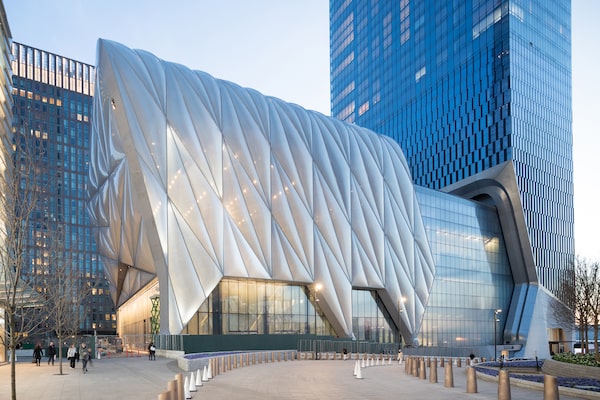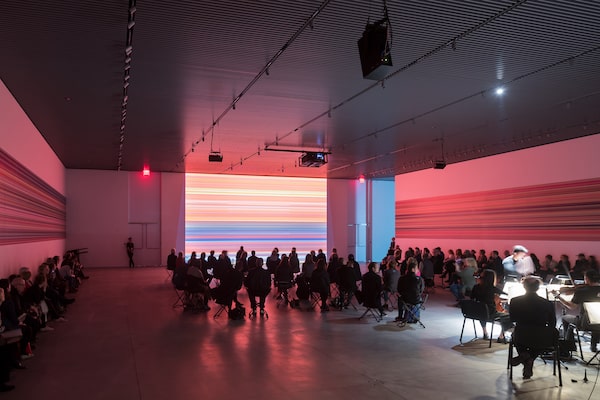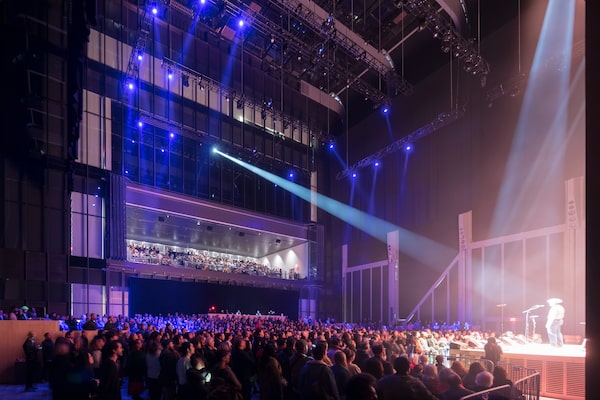
Iwan Baan/Diller Scofidio + Renfro
In a new neighbourhood designed for frictionless consumption, where does art fit in? In The Shed. This is the promise of an arts institution that opened two weeks ago at Hudson Yards in New York. The name of the US$500-million building promises unfussy and flexible space, something to contrast the shiny surfaces at the Rolex and Piaget boutiques.
“It’s robust; it can take a beating,” said the architect Elizabeth Diller, the central force behind The Shed. “I’m really looking forward to the building being used and abused.” The 200,000-square-foot structure, designed by architects Diller Scofidio + Renfro (DS+R) with Rockwell Group, is not quite as rugged or transgressive as Diller implies — but it does provide some forceful big ideas, and asserts the presence of a weirder and more interesting New York.
New York’s new Hudson Yards: When is a mall not a mall?
Flexibility for all kinds of art is the building’s mission, drawn from radical Modernist precedents. The veteran avant-gardistes DS+R are known for provocative big ideas, and The Shed provides one: It moves. It consists of two pieces, a solid block and a moveable shell. The showpiece is the latter, an upside-down U of translucent plastic panels: an extra-extra-large puffer jacket. This garment-like enclosure can roll back and forth on steel wheels.

Visitors take in Reich Richter Pärt, a musical performance combined with an exhibition of new work by Gerhard Richter.Iwan Baan/Diller Scofidio + Renfro
When it’s retracted, it encloses the eight-storey main block, which includes a black box theatre, galleries and rehearsal spaces. When the roof is extended — as it is this month — it covers part of the adjacent plaza, creating a cavernous performance hall called the McCourt that has standing room for 2,000.
The rest of the building is a sequence of dead-simple spaces, linked by a stack of escalators against nearby 30th Street and the High Line, the massively popular rail-line-turned-park that was partly designed by DS+R. The Shed tries to borrow the vintage-industrial vibe that characterizes the High Line, but the interior is too new and too spare to capture that vibe. The materials are dark as an architect’s wardrobe, with an abundance of polished concrete, grey glass and drywall often painted black. Rockwell has fitted out the lobby, bar and bookstore (by Canadian-owned McNally Jackson) with luxe modern furniture that doesn’t engage with the architecture’s austerity regime.
In short, the building is most remarkable for the fact that it exists, the sheer audacity of stacking all this stuff together. Diller and David Rockwell of Rockwell Group basically willed The Shed into existence, imagining the institution from scratch in response to a 2008 city call for proposals and leading it through a decade of development realpolitik. They wound up designing the residential tower attached to The Shed. “That way, we won every design argument,” Diller says dryly.

The Soundtrack of America concert series at The McCourt, the large performance space that is defined by the building’s shell when it is extended.Iwan Baan/Diller Scofidio + Renfro
But while the greatest achievement is bureaucratic, the spaces work, too. Recently I was in the McCourt for a performance of Soundtrack to America, a revue curated by Steve McQueen that traces the history of African-American music. 2,000 listeners stood on the plaza, cheering on Emily King, Samm Henshaw and Fantastic Negrito. The acoustics were fantastic; the room, though cavernous, felt alive. At the same moment, a new performance piece by Anne Carson was premiering in the black-box theatre to the east. And more.
It’s remarkable that one building has room for so much. Under director Alex Poots, The Shed is commissioning largely new work, with a strong local focus.
All this amounts to a defence of a Bohemian city now under threat. “The Shed emerges from a history of being influenced by the local art scene in the 1970s and ‘80s,” says Diller, a native New Yorker who cut her teeth in that period. “New York was a robust place of artistic production. And now, it’s becoming a place of consumption.” The High Line, though public, is now the anchor for a high-net-worth ghetto and always, always rammed. “I don’t feel great about it,” Diller admitted. Against all this, and against Hudson Yards’s corporate takeover, Diller argues that The Shed “is a place of resistance.”
If that’s its symbolic role, it is hard to ignore its physical position: The Shed is crammed into a corner of the site, crowded by the too-big Vessel and keeping well back from the shopping mall. It is marginal. But it is huge, and it is there, a fortress for art that takes up as much space as possible.
Live your best. We have a daily Life & Arts newsletter, providing you with our latest stories on health, travel, food and culture. Sign up today.
 Alex Bozikovic
Alex Bozikovic